By fabric | ch
-----
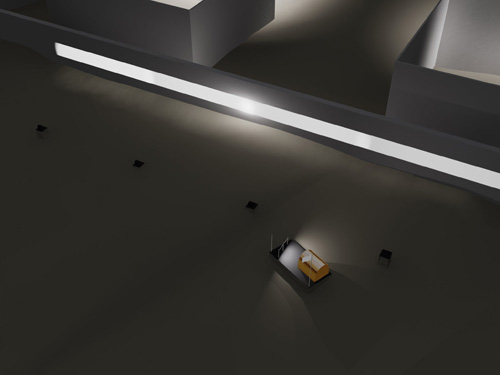
Arctic Opening is a new installation by fabric | ch, curated by Seconde Nature (curatorship: Pierre-Emmanuel Reviron) that we will install next week on the Frioul Islands in Marseille (South of France, Mediterranean Sea), in the context of the Festival MIMI (Festival des musiques innovantes et actuelles).
The installation will be freely accessible to everyone from the 30th of June to the 14th of July and is part of an outdoor exhibition presenting several works of art / experimental architecture (among which Nicolas Reeves, Lee Patterson).
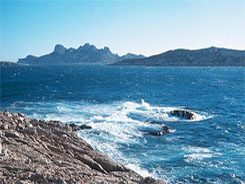
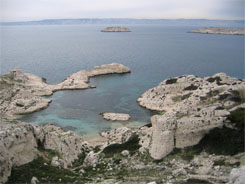
The aim of the project is to let appear a "second day" made of a large artificial ligthing, between Marseille's sunsets and sunrises, when everything becomes dark and quiet on the islands. This illumination will have its source up north, beyond the polar circle, where the sun shines 24 hours long during summer. Thus the continuous day of the arctic summer will be transported to the shore of the Mediterranean Sea.
Arctic Opening will light up a zone of the arid landscape of the Frioul close to an industrial ruin, channeling a fictional catastrophic future of an Arctic Ocean free of ice with the present of this mediterranean island, already surrounded by sea routes and heavy tourism. The result will become a metis landscape, all nights long: an arctic mediterranean, remote day at night.

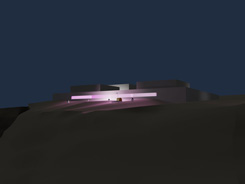
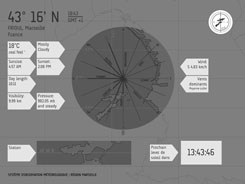
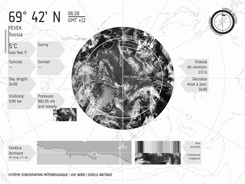
The overall installation will look a bit like a scientific expedition, with sensing devices and climatic interfaces set up under a tent, which will analyze the polar meteorologic data and control the variations of intensity of Arctic Opening.
.jpg)
--------------------------------
ARCTIC OPENING
Each day, when night falls on our urbanized landscapes in our cities, our streets or our ports, another day dawns, electric. It is literally a "second day" which begins: the one of neon signs, street lights, sodium, mercury or fluorescent lighting, the one of illuminated apartments and shops windows, the one of night activities that we did not know two centuries ago.
Although today we no longer think much about it, as this "second day" is now part of everyday life of city dwellers, this artificial light had been a conquest: by fire first, then by the gas, and more recently by electricity. This "fabricated" light permitted first to extend artificially the day at night to illuminate the darkness, but also to transform our relationship to time, to landscape and to space. It especially allowed to exceed the given natural immemorial cycle of day and night induced by the rotation of the Earth itself, and thus to redefine architectural and urban spaces.
However, that day, which has become "perpetual", has interfered since the nineteenth century with our natural rhythms, producing dramatic changes: emancipated of the natural alternation of day and night, social habits and customs of inhabitants benefiting This "discovery" found themselves immediately and irrevocably transformed. One began to live and work at night, having fun more and more under artificial light, and sometimes, as compensation, to sleep the day away. One also began to design new architectures that did not require natural lighting anymore. In a few decades, artificial lighting profoundly altered the lifestyle of city dwellers, but not only: birds began to sing at night near the lampposts, insects to swarm under the spotlights and stars to disappear of the urban night sky, opening the door to a strange world, that combines natural and artificial cycles. Losses and gains then.
This new environment was also marked by the willingness of men to control the "randomness" or the "wildness" to take control of a growing number of factors and constitutive dimensions of their habitat. Today, this "second day", historically "industrial", is still often a day with a monotone lighting, having essentially a functional goal (to see, to secure, to work, but also to read, to cook, etc..). Mostly, it evokes nothing, and if it varies, it is to stay in a comfort zone preset unlike natural climates which are constantly playing with landscape to offer different uses and perceptions of a same environment. In addition we are just beginning to take the measure of the energy cost of that enterprise and its participation in global ecological negative balance of humanity. Yet this environment, sometimes magical, sometimes disturbing, develops undoubtedly for us a poetry of shifts. Now, the challenge is to deploy these shifts, which combine presents and futures, into a comprehensive reflection on our contemporary space and our consumption of energy.
Designed for the Innovative Music Festival (MIMI 2010) in Marseille, on the Frioul islands, Arctic Opening does not aim to deny this "second day", but to amplify its positive and sensitive issues. Thus, Arctic Opening seeks to develop the potential of imagination(s) of artificial illumination, while integrating new technologies and intelligent lighting cycles of low energy consumption.
In a global environment, endlessly interconnected, which develops new forms of mobility, temporalities, and social behaviours at the crossings of time zones, this artificial day provides an opportunity for another kind of "days", simultaneous and distant: an imaginary or mediated "connection" with countries where precisely and literally, at the same time, the sun is shinning. Through satellite imagery and sensor data, it is now possible to imagine opening a "window" onto a sensitive and remote light whose intensity varies continuously, the sky is sunny, then cloudy, then possibly sunny again. A window "teleporting" abstractly a remote atmosphere without physical mobility, without means of transport other than transportation data from there to here.
With Arctic Opening, fabric | ch proposes to create such an "opening" at a large scale, to another day: an artificial and sensitive light, revealing some geographical patterns, luminous and meteorological, across the globe (to the summer of one hemisphere corresponds the winter of the other, to the daylight the darkness, to the perpetual light of a pole the night of the other, etc.). When night falls over Marseille this "second day" gets up with its source somewhere north of the Arctic Circle, on the edge of the habitable zones (Hammerfest, Murmansk, Prudhoe Bay, Tuktoyaktuk, Igloolik, Clyde River, Scoresby, etc.), where once the ice melted new navigation routes open and will open more and more in the future. Fed by light coming from regions, where in this season, the horizontal light of the sun never sets, where sunrise and sunset mix, Arctic Opening reproduces the continuous modulation of the northern summer. Composed of hundreds of light emitting diodes (LEDs), this bright band long of eighteen meters illuminates a rocky landscape, swept by winds. At sunrise, it goes slowly to reveal a temporary installation of pipes, placed there to conduct this experiment in distant light. Erected near the vicinity of a military and industrial relic of the twentieth century, a tent hosting the instruments of control suggests a possible scientific expedition in an "hostile" zone.
The combination of light produced by this window and the Frioul islands' landscape produces a composite territory: Arctic Mediterranea, remote nocturnal day.
This hybrid area in mixed light is purposely created as a prospective environment, which evokes the contemporary patterns of mobility and crossing time zones, the fluxes and and the networks, the artificiality and the mediatisation, or to indicate the strange topographic similarities between the arid Frioul islands and the Arctic regions where no tree grows. As if this temporary place in front of Marseille, illuminated by a light transported from the Arctic could become the distant, catastrophic and fictitious future of these northern territories: warmed by climatic changes, visited by boats navigating on new routes opened by melting ice, the shores of the Far North could begin to resemble those of the Mediterranean Sea. This environment would then hybridise himself as well, as people become increasingly mobile over time: mix of here and elsewhere, future and present, material and immaterial.
Arctic Opening: mixed territories.
fabric | ch, June 2010.
--------------------------------
Original Text (in French):
FENÊTRE ARCTIQUE
Chaque jour, lorsque la nuit tombe sur nos paysages urbanisés, dans nos villes, nos rues ou nos ports, un autre jour se lève, électrique. C'est littéralement une " seconde journée " qui commence : celle des néons et des enseignes, des éclairages publics au sodium, au mercure ou à la fluorescence, celle encore des fenêtres et des vitrines illuminées, celle enfin d'une effervescence nocturne que nous ne connaissions pas il y a encore deux siècles.
Bien qu'aujourd'hui nous n'y pensions plus guère, tant ce " deuxième jour " fait dorénavant partie de notre quotidien de citadins, cet éclairage fut une conquête : par le feu en premier lieu, par le gaz ensuite, et plus récemment par l'électricité. Cette lumière " fabriquée " permit d'abord de prolonger de façon artificielle le jour durant la nuit, d'éclairer la pénombre, mais aussi d'architecturer et de transformer de façon radicale notre relation au temps, au paysage, à l'espace. Elle permit surtout de dépasser cette donnée naturelle, immémoriale et incontournable qu'a toujours été le cycle du jour et de la nuit induit par la rotation de la Terre sur elle-même, et de redéfinir ainsi l'espace architectural et urbain.
Cependant, ce jour devenu " perpétuel " grâce à l'électricité interféra dès le XIXème siècle avec nos rythmes naturels, produisant des modifications spectaculaires : émancipés de l'alternance diurne et nocturne imposée par la nature, les habitudes sociales et les usages des habitants bénéficiant de cette " découverte " se retrouvèrent immédiatement et irrémédiablement transformés. On se mit à vivre et travailler la nuit, à se divertir de plus en plus sous un éclairage artificiel, et parfois, en compensation, à dormir le jour… à l'abri des persiennes (autre système, mécanique celui-ci, de contrôle du climat et de la lumière). On se mit aussi à concevoir de nouvelles architectures qui ne nécessitaient plus d'éclairage naturel. En quelques décennies, l'éclairage artificiel modifia en profondeur les modes de vie des citadins, mais pas uniquement : les oiseaux se mirent à chanter la nuit à proximité des lampadaires, les insectes à s'agglutiner sous les projecteurs et les étoiles à s'effacer partiellement du ciel nocturne urbain, ouvrant ainsi la porte à un univers étrange, transformé et où se mêlent cycles naturels et artificiels. Pertes et gains donc.
Ce nouvel environnement fut également marqué par la volonté des hommes d'en maîtriser l'" aléatoire " ou le " sauvage " pour prendre le contrôle d'un nombre grandissant de facteurs et de dimensions constitutives de leur habitat. Aujourd'hui encore, cette " deuxième journée ", historiquement " industrielle ", demeure souvent un jour à la lumière monotone, à vocation essentiellement fonctionnelle (voir, sécuriser, travailler, mais aussi lire, cuisiner, etc.). La plupart du temps, elle n'évoque rien, et si elle varie, c'est pour rester dans une zone de confort préprogrammée, au contraire des climats lumineux naturels qui jouent continuellement avec le paysage pour offrir différentes occupations et perceptions d'un même environnement. De plus nous commençons à peine à prendre la mesure du coût énergétique de cette entreprise et de sa participation au bilan écologique global négatif de l'humanité. Pourtant, cet environnement, parfois magique, parfois inquiétant, développe pour nous, incontestablement, une poésie des décalages. Ces décalages qui mêlent présents et futurs, il s'agit de les déployer dans une réflexion d'ensemble sur notre espace contemporain et notre consommation d'énergie.
Conçu pour le Festival des Musiques Innovantes (MIMI) 2010 à Marseille, sur les îles du Frioul, le projet Fenêtre Arctique n'a donc pas pour objectif de nier cette " deuxième journée ", mais d'en amplifier les aspects sensibles et positifs. Fenêtre Arctique cherche ainsi à développer le potentiel d'imaginaire(s)de l'illumination artificielle, tout en intégrant les nouvelles technologies et les cycles d'éclairage intelligents à faible consommation énergétiques.
Dans un environnement désormais mondialisé, perpétuellement interconnecté, où se développent de nouvelles mobilités, temporalités et comportements sociaux aux croisements des fuseaux horaires, ce jour artificiel offre l'occasion d'une ouverture vers d'autres jours, simultanés et distants : une " connexion " imaginaire ou médiatisée avec des contrées où précisément et littéralement, au même instant, il fait jour. Par le biais d'images satellites et de capteurs de données, il est désormais possible d'imaginer ouvrir une " fenêtre " sur une lumière sensible et éloignée dont l'intensité varie, continuellement, où le ciel est ensoleillé, puis couvert, puis éventuellement ensoleillé à nouveau. Une fenêtre " téléportant " de façon abstraite une atmosphère distante, sans mobilité physique, sans moyen de transport autre que le transport des données, de là-bas à ici.
Avec Fenêtre Arctique, fabric | ch se propose de créer une telle " ouverture " à large échelle, vers un autre jour, durable et distant : une clarté artificielle, sensible, révélant certains motifs géographiques, lumineux et météorologiques, à l'échelle du globe (à l'été d'un hémisphère correspond en opposé l'hiver de l'autre, au clair l'obscur, au jour perpétuel d'un pôle la nuit de l'autre, etc.). Lorsque la nuit tombe sur Marseille, ce " deuxième jour " se lève en prenant sa source quelque part au nord du Cercle Arctique, aux confins des zones habitables (Hammerfest, Murmansk, Prudhoe Bay, Tuktoyaktuk, Igloolik, Clyde River, Scoresbysund, etc.), où une fois les glaces fondues de nouvelles routes maritimes s'ouvrent et s'ouvriront plus encore à l'avenir. Alimentée par la lumière de contrées, où, en cette saison, le soleil à l'éclairage horizontal ne se couche jamais, où son lever se mêle à son coucher, Fenêtre Arctique reproduit les modulations continuelles de l'été septentrional. Composée de centaines de diodes électroluminescentes (LEDs), cette bande lumineuse longue de dix-huit mètres éclaire un paysage rocailleux, balayé par les vents. Au lever du soleil, elle s'éteint lentement pour laisser apparaître une installation temporaire de tubulures, plantées là pour mener cette expérience en lumière distante. Dressée à proximité, au voisinage d'un vestige militaire et industriel du XXème siècle, une tente abritant des instruments de contrôle évoque une possible expédition scientifique en milieu " hostile ".
La combinaison de l'éclairage produit par cette fenêtre et le paysage des îles du Frioul engendre un territoire composite : Méditerranée arctique, jour distant nocturne.
Ce territoire métisse en lumière mélangée est créé à dessein comme environnement prospectif des motifs contemporains de la mobilité et du croisement des fuseaux horaires, des flux et des réseaux, de l'artificialité et de la médiatisation, ou encore pour signaler les étranges similarités topographiques entre les îles arides du Frioul et les territoires arctiques où aucun arbre ne pousse. Comme si ce lieu temporaire au large de Marseille, éclairé par une lumière reconstruite et transportée de l'arctique, pouvait révéler le futur lointain, catastrophique et fictif, de ces territoires nordiques : réchauffés par les dérèglements climatiques, parcourus par le va et vient des bateaux lancés sur les nouvelles routes maritimes ouvertes par la fonte des glaces, les rives du Grand-Nord pourraient commencer à ressembler celles de la Méditerranée. Cet environnement se métisserait alors, lui-aussi, à la façon des populations devenues de plus en plus mobiles au fil du temps : mélanges d'ici et d'ailleurs, de futurs et de présents, de matériel et d'immatériel.
Fenêtre Arctique : territoires mélangés.
fabric | ch, juin 2010.
--------------------------------
Project, conception and programmation: fabric | ch
Ligths: Lumens8
On site supervision: Etienne Fortin, AMI
MIMI Direction: Ferdinand Richard, AMI
Curatorship: Pierre-Emmanuel Reviron, Seconde Nature
With the support of Marseille-Provence 2013, MIMI Festival and Lumens8. Arctic Opening is a MIMI 2010 creation by fabric | ch.







.jpg)
